This article first appeared in Spark, and is reprinted here with their permission. It’s somewhat long, and it’s got numbers and graphs. It helps if you imagine Scarlett Johansson reading it.
When it comes to power generation, coal isn’t cheap. Both power plant and fuel costs are up by nearly 300%, and projected to rise farther1. Even before factoring in the risks of future greenhouse gas legislation, this has conspired to make a bet on coal-fired central station power equivalent to a bet on massive retail power price increases. Increasingly, this is a bet that neither equity nor debt providers are willing to take.
And yet we continue to operate under the assumption that coal is cheap — to the extent that we have largely framed our greenhouse gas policy conversation as a tradeoff between environmental stewardship and the cheap coal fantasy.
On balance, this is good news, because it means that the perceived conflict at the heart of our current climate change debate is false. We need not quibble about whether or not we can afford to address global warming; indeed, we can lower greenhouse gases and grow the economy. But first, we have to get beyond coal.
The Electric Sector’s Role in Greenhouse Gas Emissions
In the United States, coal is primarily a power plant fuel, and the electricity sector is our single biggest source of greenhouse gas (GHG) emissions. As a result, any discussion of greenhouse gas reduction must confront coal-based electricity. Figure 1 shows total US greenhouse gas emissions by sector, and Figure 2 shows how the electric sector has steadily increased its share thereof.
Figure 1: 2005 US Greenhouse Gas Emissions, By Source2
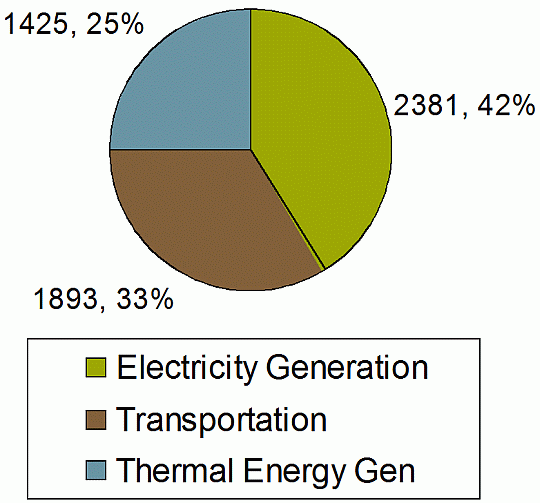
Figure 2: US GHG Emissions History and Percent from Electricity Generation: 1949 — 20053
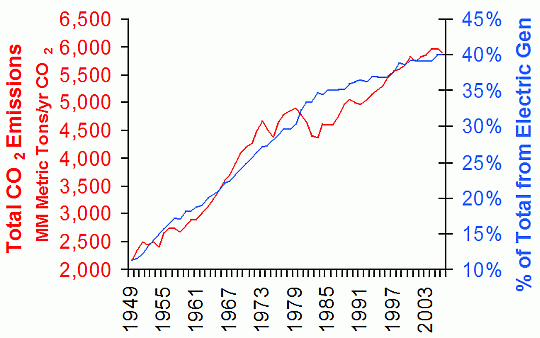 The trends seen in Figure 2 reflect our nation’s steady and inexorable electrification — first as we switched from candles to electric light, then as we shifted away from mechanical power, then later as waves of computerization and air conditioning enabled great leaps in our national standard of living. As we now shift from a manufacturing- to a service-intensive economy, this trend will undoubtedly continue — and so we will increasingly find that efforts to curtail greenhouse gas emissions must focus on our electric sector.
The trends seen in Figure 2 reflect our nation’s steady and inexorable electrification — first as we switched from candles to electric light, then as we shifted away from mechanical power, then later as waves of computerization and air conditioning enabled great leaps in our national standard of living. As we now shift from a manufacturing- to a service-intensive economy, this trend will undoubtedly continue — and so we will increasingly find that efforts to curtail greenhouse gas emissions must focus on our electric sector.
For rather perverse reasons, this is good news. The electric sector today is only half as fuel efficient as it was in 1910, implying that we could cut CO2 emission from the electric sector in half and lower electricity costs simply by deploying century-old technologies and regulatory models.
Figure 3: US Electric Sector Fuel Efficiency History, 1880 — Present
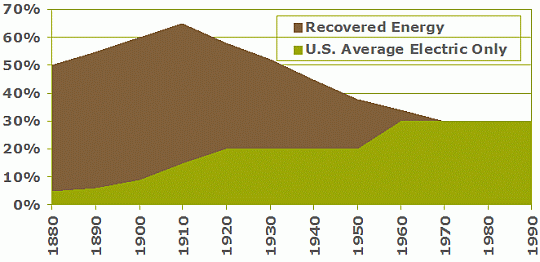
How did this happen?
Thomas Edison’s first power plant was much less efficient than today’s grid at converting fuel to electricity, but Edison wasn’t in business to make electricity: he was in business to make money. Therefore, he recovered as much of his waste energy as possible in the form of thermal energy and sold that to neighboring commercial and industrial facilities. This combined heat and power generation continued as the standard approach during the early part of the 20th century when, to speed electrification, governments created electric monopoly franchises. The monopoly model sped up electrification but removed the free-market impulse that drove the first three decades of the industry. In place of competition, the industry was ceded to protected monopolies, wherein profits were earned not by controlling costs and increasing revenues, but rather by deploying commission-approved capital to earn a commission-approved return. Under these rules, operating costs are simply passed along to customers, on the theory that monopolies should not be rewarded for spending money. As a practical matter, this eliminated the incentive to reduce operating costs. Since power plant operating costs are dominated by fuel, this has both economic and environmental consequences.
This regulatory flaw is the elephant in the room. Fix the regulation, and good things will happen. But until we do so, we cannot assume that GHG mitigation is incompatible with economic growth.
Let us now look at how the conventional wisdom that “coal is cheap” is also at odds with reality.
The Coal Truth, and Nothing but the Truth
Coal is a cheap fuel. Relative to natural gas, oil and even biomass, coal remains quite cheap, even after 200% price increases in spot coal since 1999. But who cares? You can’t run your iPod with coal. And if it was only the variable costs of fuel that mattered, we would have a nation full of solar and wind-powered generation, which have zero fuel cost. The economic number that matters is not the price of fuel, but the delivered cost of electricity, including fuel cost, capital recovery, pollution control costs, maintenance expense, transmission and distribution capital recovery and line losses.
Let us then look at how investors — who have good reasons to factor all capital and operating costs into their calculus — have allocated their capital amongst generation technologies.
From a generation perspective, the US power grid has only four significant fuel sources: hydro, nuclear, coal and natural gas. Of the four, hydro has the lowest marginal costs and runs whenever the water flows. However, the US hasn’t built any hydropower of any significance in 50 years, largely because the biggest potential sources have already been tapped4. As a result, even while the total generation from hydropower stays relatively consistent from year to year at 200 — 300 billion kWh, it has become an ever smaller percent of our total mix due to load growth, from 32% in 1949 to just 6% today.
Nuclear has the next cheapest variable costs, but has the highest capital costs. As such, it has only been built when governments have agreed to subsidize plant capital cost and insurance risks. However, with variable costs in the range of 1 cent/kWh, nuclear plants tend to run as often as they can once built.
Coal has historically been next on the marginal price curve, at 2 — 4 cents per kWh marginal operating costs at the generator buss bar, followed by natural gas at 6 — 8 cents/kWh (at current fuel prices).
This “dispatch order” explains how marginal electric pricing works, but says nothing about the investment thesis for any given generation technology. After all, no investor wants to build a power plant that only earns marginal pricing. As a result, we infer something about total costs by looking at which technologies were built in response to variable electric prices. Given the long time horizon of power plant investment and operation, we will look over the past 30 years, going back to the beginning of the OPEC energy price run-up in the late 1970s.
Figure 4 shows the inflation adjusted, retail price of power in the US over this period.
Figure 4: US Average Retail Electric Price (2006 $)5
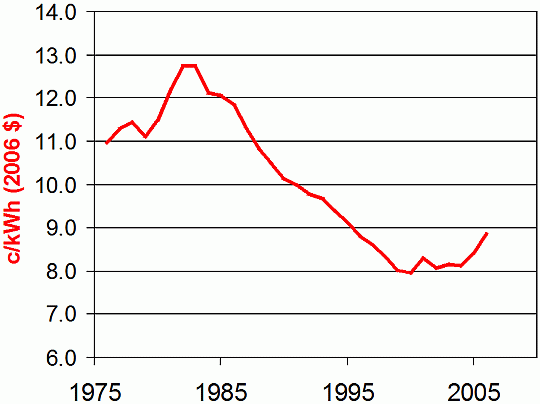
The increase in electricity price in the late 1970s was based in large part on a global increase in all energy costs as a result of OPEC price shocks. What accounts for the current increase?
First, recall that we can’t build the really cheap stuff (hydro) anymore — which means that everything we have built since has tended to increase the average price. However, the cessation of hydro investments occurred decades ago — far too long to explain the 2000 price inversion.
Things get a bit more interesting if we look at the nuclear fleet. As Figure 5 shows, we haven’t added any new nuclear capacity since 1990. (While the 1979 accident at Three Mile Island turned public opinion against new nuclear plants, we continued building those plants that were already “in the pipeline” over the subsequent decade.)
Figure 5: US Retail Electric Rate History and Nuclear Capacity History

At first glance, the slowdown in nuclear plant construction doesn’t appear to explain the 2000 uptick in power costs. But a generator doesn’t have any impact on power prices unless it runs. Thus, it is not only the capacity of the generator that matters, but also the number of hours the generator operates.
Figure 6 shows the nuclear fleet’s capacity factor over the same period, calculated as the number of GWh generated from the entire fleet relative to the maximum it could have generated if it ran at full rated power output for 24 hours/day, 365 days/year.
Figure 6: US Retail Electric Rate History and Nuclear Capacity Factor History6

A cause for the recent price increases now comes into focus. While we stopped building new nuclear capacity in 1990, the fleet had a lot of “spare” room, running at only 60% of its potential. But by 2003, nuclear fleet capacity factor had saturated at 90%, about as high as it can go given maintenance constraints.7 As the nuclear fleet capacity factor leveled off, we see power prices rise; after all, with no more increases of marginal nuclear generation available, load growth had to be served by higher priced alternatives.
Now let’s shift our focus to coal. Interestingly, the coal fleet also sees a leveling off of generation additions in about 1990, just about concurrent with the curtailment of new nuclear capacity additions.
Figure 7: US Retail Electric Rate History and Coal Capacity History
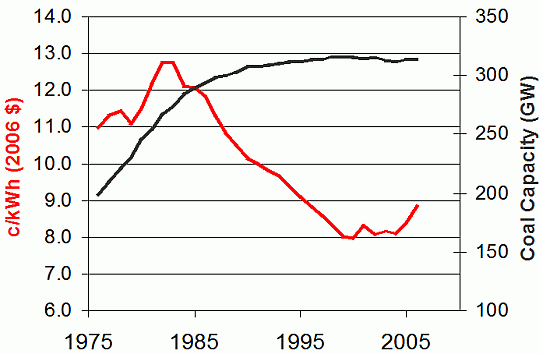
Like the nuclear slow-down, the causes of the coal slowdown are — in hindsight — understandable. The 1976 Clean Air Act (CAA) dramatically raised the cost of new coal plants, but grandfathered the existing coal plants out of compliance obligations. This essentially eliminated the economic logic for new coal plant construction — and explains the absence of coal fleet growth over the past two decades8.
And what about coal plant capacity factor? Today’s fleet has a 72% capacity factor, suggesting that it still has room to grow. This figure is deceptive though. In many regions of the country, the total generation capacity represented by the combined nuclear, hydro and coal fleets exceeds the off-peak demand. As the most expensive of these three sources, central coal plants are the first source curtailed during low demand periods, and it is thus not possible to run the coal fleet at the capacity factors seen in the nuclear industry until the base power demand grows. Thus, the relevant question for coal is how the total fleet MWh output has grown relative to the growth in overall retail electricity purchases9 , as shown in Figure 8.
Figure 8: US Retail Electric Rate history and Coal MWh growth relative to load10
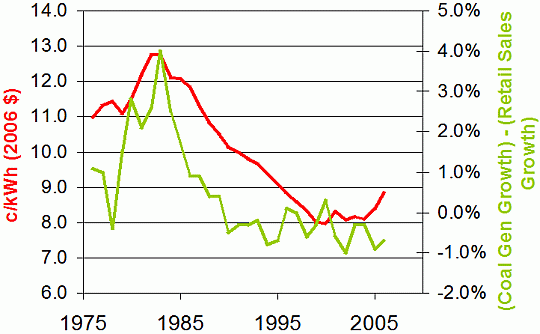
Note that since 1990, coal growth relative to retail sales growth has been essentially zero. In other words, the coal fleet is already running as hard as it can, subject to the limits of demand. As demand has risen, the coal fleet has been able to increase its capacity factor to keep up, but it has essentially been a non-factor in the provision of peak loads since 1990. In other words, since the nuclear fleet capacity factor saturated in 2003, peak load has had to come from sources other than old hydro, old nuclear and old coal.
We are thus faced with a question: if coal is cheap, why isn’t anyone building it? And more broadly, if we’re not building nuclear, not building coal, and not building hydro … what are we building?
Which brings us to natural gas.
Unlike nuclear and coal, natural gas is a relatively low-risk fuel from an environmental perspective: Clean Air Act compliance is (comparatively) minor, and the siting challenges are orders of magnitude lower than either nuclear or coal-based assets. In addition, the cessation of nuclear and coal construction in 1990 was followed shortly thereafter by the 1992 Energy Policy Act and FERC order 888 which — for the first time — allowed private capital to meaningfully participate in wholesale power markets. This combination of environmental considerations and market liberalization persuaded many independent power producers to invest in new natural gas plants, as seen in Figure 9. The power industry added nearly 200 GW of natural gas-fired capacity in just 5 years — a growth rate that was unprecedented in the history of the US electricity industry, for any fuel type.
Figure 9: US Retail Electric Rate History and Natural Gas Capacity History
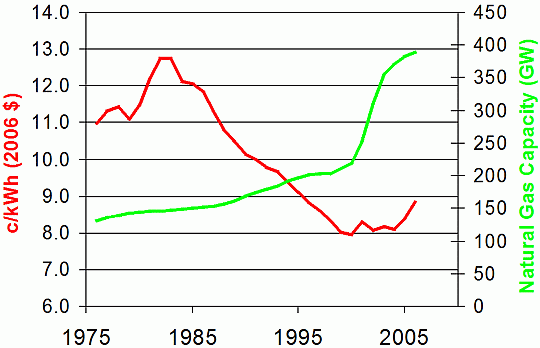
Note that even before the 1992 wholesale market liberalization, the gas fleet was growing, albeit more slowly. However, the rate of gas fleet growth slowed dramatically in the wake of rising fuel costs at the beginning of this decade.
The impact of rising natural gas costs on the investment thesis for natural gas-fired generation is readily apparent in Figure 10. As higher costs forced these plants to curtail production, equity investors lost their appetite for new gas plant construction (among other things).
Figure 10: US Retail Electric Rate History and Natural Gas Capacity Factor History

And thus we saw a wave of bankruptcies in the merchant power industry: equity capital that was deployed in anticipation of 30% utilization simply evaporated. The largest publicly-traded IPPs lost over $200 billion of shareholder value between June of 2000 and the end of 2001. This lesson is not lost on today’s would-be coal plant investors as they try to figure out whether there investments will also be driven down to run at their marginal generation costs and sacrifice capital recovery.
And so we see that the retail electric price increases that began in 2000 were the result of the cessation of nuclear and coal plant construction ten years earlier (and due to causes that occurred 10 — 15 years prior), coupled with an increase in natural gas price. This more or less comports with conventional wisdom.
But now we return to our question. If coal is so cheap, why have investors exclusively invested in natural gas plants? Even after the spike in gas prices and collapse in capacity factor, gas-fired plants remain the only technology that is still increasing generating capacity. Moreover, as Figure 11 shows, natural gas-fired generation has comprised more than 100%11 of all our capacity additions since 1996. This would imply that no one thought it was a good idea to build coal-fired plants prior to the recent increase in electricity costs — which is hardly consistent with the thesis that coal is inherently cheap.
Figure 11: US Retail Electric Price History and Percent of Total Capacity Additions from Gas12
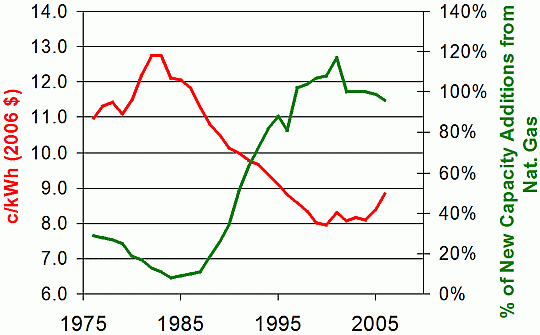 That’s because coal isn’t cheap. Clearly, the fuel is cheap — and if society is willing to tolerate pre-Clean Air Act levels of SOx, NOx, particulate and mercury emissions, you can build a relatively cheap coal plant. But society will no longer tolerate dirty coal — and investors will not tolerate an investment that doesn’t pay off its equity. Taken together, this has made central-station coal a lousy investment.
That’s because coal isn’t cheap. Clearly, the fuel is cheap — and if society is willing to tolerate pre-Clean Air Act levels of SOx, NOx, particulate and mercury emissions, you can build a relatively cheap coal plant. But society will no longer tolerate dirty coal — and investors will not tolerate an investment that doesn’t pay off its equity. Taken together, this has made central-station coal a lousy investment.
Consider these recent estimates of the capital costs for modern coal-fired power plants, remembering that old dirty coal plants cost about $800 to $1,000 per kilowatt of capacity to construct:
“… well north of $2,500 per kilowatt for supercritical coal plants … “13
“Duke said it would cost $1.83 billion [for an 800 MW power plant in North Carolina].”14 ($2,300/kW)
“GE … company executives Monday gave figures … of $2,000 to $3,000 [per kilowatt for new coal-fired power plants].”15
“Indiana utility regulators approved Duke Energy’s proposed $2 billion coal-fired … 630 MW power plant.” 16 ($3,174/kW)
“West Virginia regulators have approved American Electric Power’s plan to build a $2.3 billion [629 MW] clean coal plant”17 ($3,700/kW)
It is worth noting that none of the plants cited above include any provision for CO2 recovery or sequestration which — if FutureGen is any indication — would roughly double total capital costs and reduce net generation efficiency.18 But even these “conventional” coal plants are averaging over $2,500/kW, and increasing dramatically with each subsequent commission-approved facility.
Even with no further increases in coal plant construction costs, the economics stink. Consider a coal plant with a total installed cost of $2,500/kW and assume no cost overruns. At the low costs of capital that ratepayer-guarantees provide for regulated utilities, $2,500/kW and 70% capacity factor requires 5 cents/kWh just to recover the capital costs associated with generation.19 Fuel and operating costs add 3 — 4 cents, and transmission and distribution add another 2-3 cents. Add all together and one quickly concludes that the investment in these coal plants simply doesn’t pencil below anticipated retail prices of 10-12 cents/kWh. Even after the recent run-up in electricity rates, this would represent a 17% increase in average retail electric prices — and even more in the coal-belt, where these plants would likely be built.
Here, then is the question facing prospective coal plant investors: will you put billions of dollars at risk, in order that you can return below-market (e.g., utility-level) returns in exchange for assuming the risk that (a) retail prices will spike and (b) you will never have to pay for your greenhouse gas emissions?
Not surprisingly, no one is making that bet without first getting utility commissions or state legislatures to guarantee their equity returns. Consequently, we see much of the “cheap coal” thesis emanating from what are essentially public relations efforts directed at utility commissions and state legislators. But the PR cannot hide the fact that coal isn’t cheap, or that no one is building coal without public guarantees.
Environmentally, this is good news — because if cheap coal doesn’t exist, then there is no conflict between greenhouse gas mitigation and power from cheap coal. But — and here’s the catch — while we have massive opportunities for clean and cheap power, our current regulatory model stands in direct opposition to their deployment. The 200 GW of gas-fired generation deployed after the 1992 EPACT shows us just how quickly the private sector can act once the regulatory shackles are removed — and that was in response to very modest reform, which applied only to wholesale power. Comparable reform today could unleash a comparable flood of low-cost, low-carbon generation. But we must first reform.
Better Options
Understanding our better options first requires that we confront one final piece of flawed conventional wisdom: namely, that the US energy industry optimally allocates capital. Per this conventional wisdom, there can be no better options than the current mix of power on the grid, because markets would have seen to it to allocate capital more efficiently if such options existed. Ergo, reducing fuel consumption must impose unacceptable costs, since otherwise the changes would have already been made.
This conventional wisdom is refuted by the fuel efficiency history seen in Figure 3. Fuel is the single biggest variable cost associated with power generation. Why did the industry shift capital allocation to electric only plants that could not recycle byproduct thermal energy to displace boiler fuel? Why did industry double its fuel consumption per kilowatt-hour of delivered electricity over the last century? The answer, at core, is that the power industry does not allocate capital efficiently. This is not to say that the industry does not behave rationally with its capital: rather, it is responding rationally to regulation-enforced incentives for inefficient capital allocation.
So what to do? The political appetite for full deregulation of the electricity industry remains weak — but the need to mitigate climate change and lower energy costs grows more urgent by the day.
Fortunately, within our past failures lie the seeds of economically and environmentally beneficial reform. After all, the sign-error that is innate to our present greenhouse gas conversation means that we can lower carbon while simultaneously spurring economic growth. Addressing the flaws of our present regulatory model will allow us to access a huge volume of low-hanging fruit. Just as the Soviet bread-regulation model did not facilitate the creation of vibrant boulangeries, our current system does not encourage cheap, clean power. Thus, our failure to deploy cheaper power must be understood as a failure of the system, not as the economic impossibility of a decent bakery.
Consider: According to the US Department of Energy, there are 135,000 megawatts of feasible cogeneration projects which could be deployed in the US, all of which would be at least twice as efficient as the US average20. An EPA study identified a further 65,000 megawatts of electric generation capacity which would recycle industrial waste energy (exhaust heat, flare gas, pressure drop, etc.) and burn no incremental fossil fuel21. In aggregate, this 200 GW of power could provide 40% of US electricity needs and reduce total US greenhouse gas emissions by 20%.22 It would also generate attractive returns on equity even while lowering power costs and GHG emissions.
So why aren’t they being built? As noted previously, there is no incentive for a regulated utility to build cheap generation. And even if there were, regulated utilities simply don’t have the skills. The 200 GW opportunity identified above all requires very close integration with industrial hosts in the design, contracting, construction and operation. This integration is necessary to procure waste energy from those facilities and/or to provide thermal energy to same. But it also introduces a set of design and operational dependencies (not to mention a suite of thermal and industrial engineering skills) that are not native to electric utilities, who are best at building and dispatching big, power-only assets.
And it is therefore again appropriate to revisit our Soviet bread example. The same challenges that face the deployment of cheap, clean power in the United States today faced to a developer who wanted to put an Au Bon Pain in Moscow in 1985. The problem is the paradigm. As we begin to enter a build-cycle in our power fleet, it is urgently important for us to modernize our regulatory model so that generation will be brought on line based on least-cost considerations — as opposed to the “least cost within the present paradigm” model that currently prevails. Failure to modernize will compel us to build expensive central coal or expensive central gas, which will be disastrous for both the economy and the environment.
Conclusions
The United States is about to enter an unprecedented era of energy price increases, as a flock of thirty year old chickens — from Three Mile Island to the Clean Air Act — come home to roost. We saw price increases of a similar scale after the OPEC supply disruptions in the late 1970s, and have direct experience with the massive economic dislocation that can result. But as bad as those price shocks were, they were at least transitory. The coming price shocks are driven by structural shifts in the global economy and environment that will not be so easily reversed.
However, unlike the OPEC shocks of the 1970s, we can see these coming, and we can plan accordingly. Moreover, the challenges we are soon to face have, at their core, a single, and largely fixable cause: an outdated electricity regulatory model. This model can be fixed, but only if we are willing to confront the status quo and take off the blinders imposed by a century of central electric system planning. And when we do, we will play to our national strengths, deploying our prodigious creative and financial talents to address the greatest global problems of our day. We will lower greenhouse gas emissions. We will lower energy costs. We will create new industries and entrepreneurial success stories.
But first, we must get beyond our model of monopoly-only capital allocation. We must get beyond the false premise that economic growth is incompatible with greenhouse gas mitigation. We must get beyond coal.
—–
Footnotes
[1] On March 7, 2008, Merrill Lynch announced that they expect thermal coal prices to rise 200% by the end of the year (Greenwire, 3/7/08).
[2] From US EPA data. Total emissions across all sectors in 2005 were 5,699 teragrams, or 5.7 trillion metric tones.
[3] Source: US DOE/EIA.
[4] And of course, the public has lost its appetite for the environmental consequences of massive hydroelectric dams.
[5] Source: US DOE/EIA.
[6] Capacity factors shown are calculated as 5 year trailing averages.
[7] Nuclear fleet capacity factors before and after deregulation — and between presently regulated and presently restructured states — provide compelling evidence of the ways in which our current regulatory model prevents utilities from preferentially deploying their lowest cost generation options. For details, see Casten, Sean, “Deregulation, Phase II”, Public Utilities Fortnightly, November 2007, pp 48-54.
[8] This is not to suggest that pollution control is incompatible with low-cost generation — simply that CAA-compliance is incompatible with low-cost generation. Other regulatory approaches, like output-based standards that incentivize energy efficiency deliver equivalent or greater environmental benefit without the CAA’s economic pain.
[9] In truth, one would like to compare coal MWh growth to growth in the “troughs” of demand — e.g., during winter nights, when electricity demand is at a minimum — but this is not readily available in the data, and we use total retail sales as a surrogate.
[10] Coal growth data shown is as a 5-year trailing average.
[11] This ratio is calculated as total year-on-year natural gas capacity additions, divided by total fleet capacity growth during the same period. Since both values also include capacity retirements, this ratio can sometimes exceed 100%.
[12] Gas capacity values shown are a 5-year trailing average, comparing total natural-gas fired capacity additions in a given year to total capacity growth. In some years, this value exceeds 100% due to fleet retirements.
[13] Energy Biz Insider, 7/6/07.
[14] New York Times, 7/10/07.
[15] Ibid.
[16] E&E News, 11/27/07.
[17] Greenwire, 3/7/08.
[18] FutureGen is the (recently abandoned) plant slated for construction in Illinois that would have separated CO2 from the exhaust to sequester underground. DOE estimated costs of $1.8 billion for this 275 MW plant, or $6,500/kW. (Greenwire, 11/12/07).
[19] Calculated at 11%, 20 year level amortization.
[20] Hedman, Bruce, Combined Heat & Power and Heat Recovery as Energy Efficiency Options, Briefing to Senate Renewable Energy Caucus, Sept. 10 2007; Energy and Environmental Analysis/USCHPA, Washington DC. This work was done under contract to the US DOE, in support of their goal to deploy 90 GW of CHP by 2010.
[21] Bailey, Owen and Enrst Worrell, Clean Energy Technologies: A Preliminary Inventory of the Potential for Electricity Generation, Lawrence Berkeley National Laboratory (under contract to US EPA under US DOE contract number DE-AC02-05CH11231), April 2005. Note that this report identifies 96 GW of total potential, but some of this total includes fueled CHP applications that are redundant with the DOE-identified 135 GW total.
[22] There is approximately 1000 GW of total generation in the US today, but much of this base runs only during system peaks. The 200 GW of clean generation opportunity — by virtue of being so much cheaper than the rest of the grid — tends to run closer to baseload, as is the case for the existing 83 GW of already-installed assets. Thus, 20% of the total GW base can provide 40% of total GWh use.


